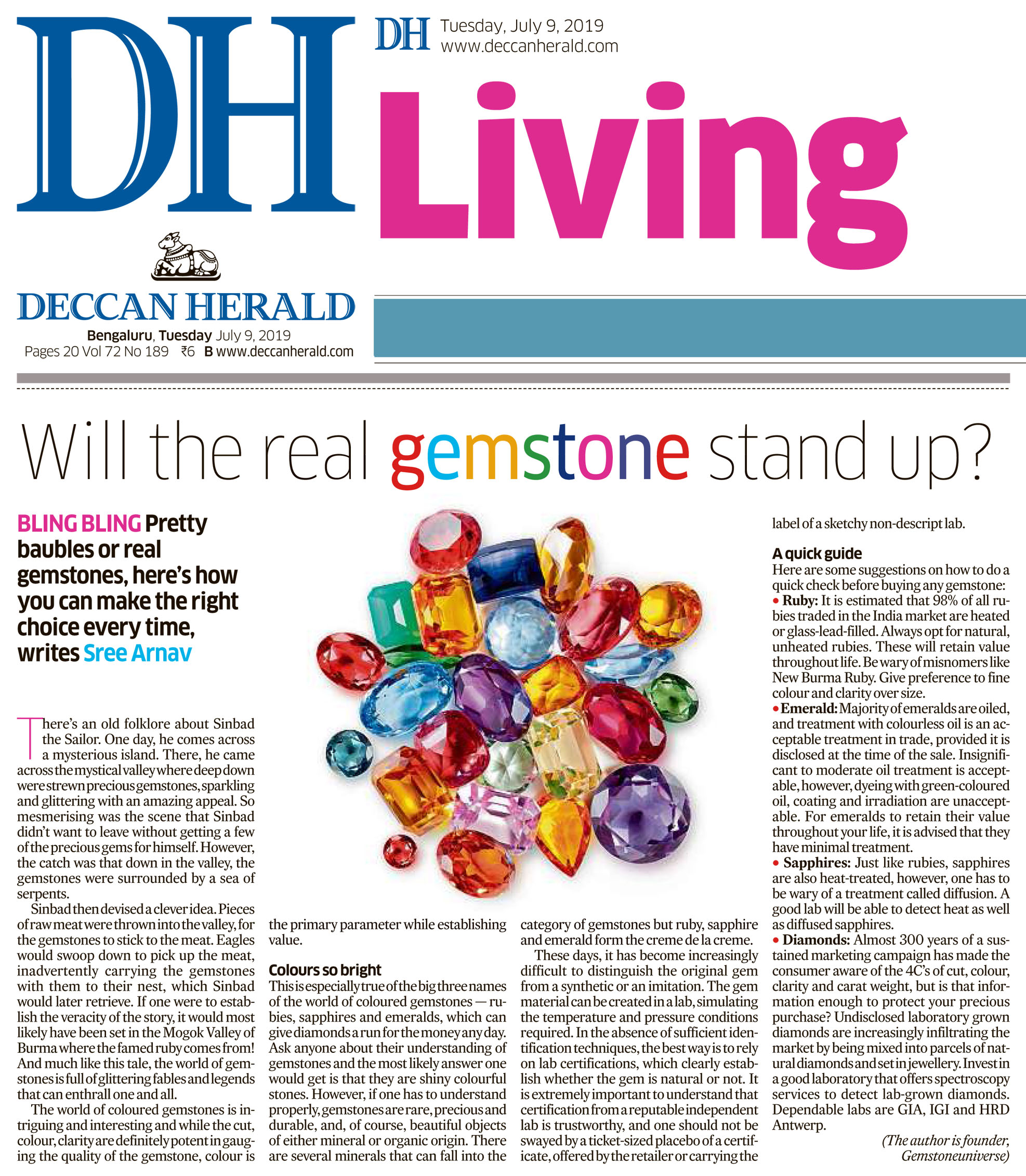Will the real gemstone stand up?
In the Media
|
||||
Will the real gemstone stand up?Pretty baubles or real gemstones, here’s how you can make the right choice every time, writes Sree ArnavAuthor: Guruji Shrii Arnav, Publisher: Deccan Herald These days, it has become increasingly difficult to distinguish the original gem from a synthetic or an imitation. There’s an old folklore about Sinbad the Sailor. One day, he comes across a mysterious island. There, he came across the mystical valley where deep down were strewn precious gemstones, sparkling and glittering with an amazing appeal. So mesmerising was the scene that Sinbad didn’t want to leave without getting a few of the precious gems for himself. However, the catch was that down in the valley, the gemstones were surrounded by a sea of serpents. Sinbad then devised a clever idea. Pieces of raw meat were thrown into the valley, for the gemstones to stick to the meat. Eagles would swoop down to pick up the meat, inadvertently carrying the gemstones with them to their nest, which Sinbad would later retrieve. If one were to establish the veracity of the story, it would most likely have been set in the Mogok Valley of Burma where the famed ruby comes from! And much like this tale, the world of gemstones is full of glittering fables and legends that can enthrall one and all. The world of coloured gemstones is intriguing and interesting and while the cut, colour, clarity are definitely potent in gauging the quality of the gemstone, colour is the primary parameter while establishing value. Colours so bright This is especially true of the big three names of the world of coloured gemstones — rubies, sapphires and emeralds, which can give diamonds a run for the money any day. Ask anyone about their understanding of gemstones and the most likely answer one would get is that they are shiny colourful stones. However, if one has to understand properly, gemstones are rare, precious and durable, and, of course, beautiful objects of either mineral or organic origin. There are several minerals that can fall into the category of gemstones but ruby, sapphire and emerald form the creme de la creme. These days, it has become increasingly difficult to distinguish the original gem from a synthetic or an imitation. The gem material can be created in a lab, simulating the temperature and pressure conditions required. In the absence of sufficient identification techniques, the best way is to rely on lab certifications, which clearly establish whether the gem is natural or not. It is extremely important to understand that certification from a reputable independent lab is trustworthy, and one should not be swayed by a ticket-sized placebo of a certificate, offered by the retailer or carrying the label of a sketchy non-descript lab. A quick guide Here are some suggestions on how to do a quick check before buying any gemstone: • Ruby: It is estimated that 98% of all rubies traded in the India market are heated or glass-lead-filled. Always opt for natural, unheated rubies. These will retain value throughout life. Be wary of misnomers like New Burma Ruby. Give preference to fine colour and clarity over size. • Emerald: Majority of emeralds are oiled, and treatment with colourless oil is an acceptable treatment in trade, provided it is disclosed at the time of the sale. Insignificant to moderate oil treatment is acceptable, however, dyeing with green-coloured oil, coating and irradiation are unacceptable. For emeralds to retain their value throughout your life, it is advised that they have minimal treatment. • Sapphires: Just like rubies, sapphires are also heat-treated, however, one has to be wary of a treatment called diffusion. A good lab will be able to detect heat as well as diffused sapphires. • Diamonds: Almost 300 years of a sustained marketing campaign has made the consumer aware of the 4C’s of cut, colour, clarity and carat weight, but is that information enough to protect your precious purchase? Undisclosed laboratory grown diamonds are increasingly infiltrating the market by being mixed into parcels of natural diamonds and set in jewellery. Invest in a good laboratory that offers spectroscopy services to detect lab-grown diamonds. Dependable labs are GIA, IGI and HRD Antwerp. (The author is founder, Gemstoneuniverse) |
||||
|
Read full story by clicking here |


